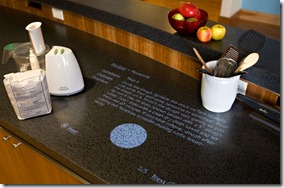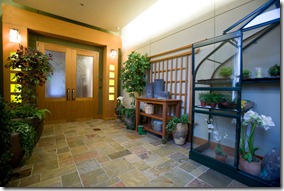Last year we published a short video with me touring the Microsoft Home – shown above – it’s a facility we have on our main campus in Redmond that explores what technology may be commonplace in homes in the next 5-10 years. For that reason it’s not a Jetsons like place and is much more grounded in what real homes may look like and how technology may be woven in to them.
With woven in mind, I got thinking about yesterday’s post on the blending of the physical and digital with respect to the Microsoft Home. I was there last week and with this new terminology in my mind, it cast some of the demos in a new light for me. Here are some of the examples where the physical elements of the home blend with digital technology.
- outside of the front door, a plant has a small sensor that monitors moisture. When the plant needs watering, it signals this with small blinking LED and an alert to the homeowners phone when they are in proximity to the plant.
- inside the home, a bookcase is constructed with digital photo frames in its panels. when an object (e.g. a model of the Eiffel Tower) is placed on the bookcase, the photo frames light up with images from Paris, France – not due to object recognition (though that’s possible) but RFID tagging that links the purchase place of the object with digital photos taken at the same time.
- the kitchen counter is one of the ‘greatest hits’ of the Microsoft Home – returning visitors always ask for it. The kitchen countertop employs a combination of RFID readers, projection and an audio array to deliver in interactive surface. When a bag of flour is placed on the surface along with a food blender, the user is promoted with a visual display and audio asking if they need a manual for the process or a recipe to make bread or cookies (based on knowing that there are also eggs in the refrigerator).
- the dining room has a table that uses similar projection techniques to turn the surface into a multiplayer kids game or can guide you through making origami with real paper by projecting instructions and fold patterns on to the paper.
There are several other examples in the home but these are a few that helped me go beyond thinking of the blending of physical and digital as a synonym for augmented reality. What I also found interesting about these examples is the seamless way they’re woven in to the home – they don’t feel clunky in the way some AR applications I’ve used are. This is a big part of why I think the blending of physical and digital is closely tied to another trend I’ve talked about a lot on this blog – natural user interfaces. The more we can weave digital and physical in seamless ways such as those in the home, the more natural the interactions will be and more importantly, the more likely we are to accept and adopt them as commonplace.






